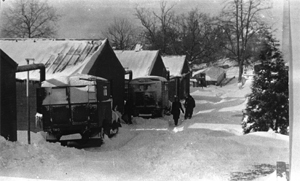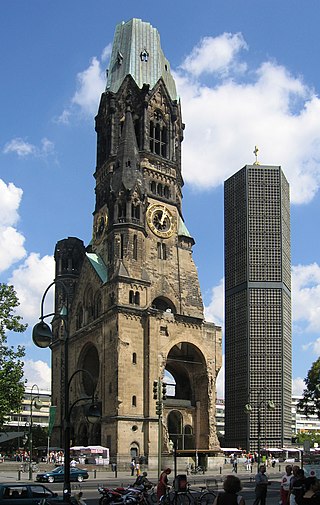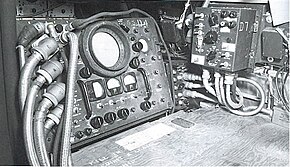
The North American B-25 Mitchell is an American medium bomber that was introduced in 1941 and named in honor of Brigadier General William "Billy" Mitchell, a pioneer of U.S. military aviation. Used by many Allied air forces, the B-25 served in every theater of World War II, and after the war ended, many remained in service, operating across four decades. Produced in numerous variants, nearly 10,000 B-25s were built. It was the most-produced American medium bomber and the third most-produced American bomber overall. These included several limited models such as the F-10 reconnaissance aircraft, the AT-24 crew trainers, and the United States Marine Corps' PBJ-1 patrol bomber.

The Avro Lancaster, commonly known as the Lancaster Bomber, is a British Second World War heavy bomber. It was designed and manufactured by Avro as a contemporary of the Handley Page Halifax, both bombers having been developed to the same specification, as well as the Short Stirling, all three aircraft being four-engined heavy bombers adopted by the Royal Air Force (RAF) during the same era.

A night fighter is a largely historical term for a fighter or interceptor aircraft adapted or designed for effective use at night, during periods of adverse meteorological conditions, or in otherwise poor visibility. Such designs were in direct contrast to day fighters: fighters and interceptors designed primarily for use during the day or during good weather. The concept of the night fighter was developed and experimented with during the First World War but would not see widespread use until WWII. The term would be supplanted by “all-weather fighter/interceptor” post-WWII, with advancements in various technologies permitting the use of such aircraft in virtually all conditions.

The Consolidated B-24 Liberator is an American heavy bomber, designed by Consolidated Aircraft of San Diego, California. It was known within the company as the Model 32, and some initial production aircraft were laid down as export models designated as various LB-30s, in the Land Bomber design category.
The Pathfinders were target-marking squadrons in RAF Bomber Command during World War II. They located and marked targets with flares, at which a main bomber force could aim, increasing the accuracy of their bombing. The Pathfinders were normally the first to receive new blind-bombing aids such as Gee, Oboe and the H2S radar.

H2S was the first airborne, ground scanning radar system. It was developed for the Royal Air Force's Bomber Command during World War II to identify targets on the ground for night and all-weather bombing. This allowed attacks outside the range of the various radio navigation aids like Gee or Oboe, which were limited to about 350 kilometres (220 mi) of range from various base stations. It was also widely used as a general navigation system, allowing landmarks to be identified at long range.

The Naxos radar warning receiver was a World War II German countermeasure to S band microwave radar produced by a cavity magnetron. Introduced in September 1943, it replaced Metox, which was incapable of detecting centimetric radar. Two versions were widely used, the FuG 350 Naxos Z that allowed night fighters to home in on H2S radars carried by RAF Bomber Command aircraft, and the FuMB 7 Naxos U for U-boats, offering early warning of the approach of RAF Coastal Command patrol aircraft equipped with ASV Mark III radar. A later model, Naxos ZR, provided warning of the approach of RAF night fighters equipped with AI Mk. VIII radar.

Oboe was a British bomb aiming system developed to allow their aircraft to bomb targets accurately in any type of weather, day or night. Oboe coupled radar tracking with radio transponder technology. The guidance system used two well-separated radar stations to track the aircraft. Two circles were created before the mission, one around each station, such that they intersected at the bomb drop point. The operators used the radars, aided by transponders on the aircraft, to guide the bomber along one of the two circles and drop the bombs when they reached the intersection.

The Telecommunications Research Establishment (TRE) was the main United Kingdom research and development organisation for radio navigation, radar, infra-red detection for heat seeking missiles, and related work for the Royal Air Force (RAF) during World War II and the years that followed. It was regarded as "the most brilliant and successful of the English wartime research establishments" under "Rowe, who saw more of the English scientific choices between 1935 and 1945 than any single man."
Serrate was a World War II Allied radar detection and homing device that was used by night fighters to track Luftwaffe night fighters equipped with the earlier UHF-band BC and C-1 versions of the Lichtenstein radar. It allowed RAF night fighters to attack their German counterparts, disrupting their attempts to attack the RAF's bomber force.

The Battle of Berlin was a bombing campaign against Berlin by RAF Bomber Command, along with raids on other German cities to keep German defences dispersed and which was a part of the bombing of Berlin during the strategic bombing of Germany in the Second World War. Air Chief Marshal Arthur Harris, Air Officer Commanding-in-Chief (AOC-in-C) Bomber Command, believed that "we can wreck Berlin from end to end if the USAAF come in with us. It will cost us between 400 and 500 aircraft. It will cost Germany the war".
Wing Commander Bransome Arthur "Branse" Burbridge, was a Royal Air Force (RAF) night fighter pilot and flying ace—a pilot credited with at least five enemy aircraft destroyed—who holds the Allied record of 21 aerial victories achieved at night during the Second World War.

The AN/APQ-13 radar was an American ground scanning radar developed by Bell Laboratories, Western Electric, and MIT as an improved model of the airborne H2X radar, itself developed from the first ground scanning radar, the British H2S radar. It was used on B-29s during World War II in the Pacific theater for high altitude area bombing, search and navigation. Computation for bombing could be performed by an impact predictor. A range unit permitted a high degree of accuracy in locating beacons. The radome was carried on the aircraft belly between the bomb bays and was partially retractable on early models. The radar operated at a frequency of 9375 ± 45 megahertz and used a superheterodyne receiver.

The Mid-Atlantic gap is a geographical term applied to an undefended area of the Atlantic Ocean during the Battle of the Atlantic in the Second World War. The region was beyond the reach of land-based RAF Coastal Command antisubmarine (A/S) aircraft. This resulted in heavy merchant shipping losses to U-boats. It is frequently known as The Black Pit, as well as the Atlantic Gap, Air Gap, Greenland Gap, or just "the Gap". The gap was eventually closed in May 1943, as growing numbers of VLR Liberators and escort carriers became available, and as basing problems were addressed.

The 482d Operations Group is a United States Air Force Reserve unit assigned to the 482d Fighter Wing. It is stationed at Homestead Air Reserve Base, Florida.

The de Havilland Mosquito was a British light bomber that served in many roles during and after the Second World War. Mosquito-equipped squadrons performed medium bomber, reconnaissance, tactical strike, anti-submarine warfare and shipping attack and night fighter duties, both defensive and offensive. Mosquitos were widely used by the RAF Pathfinder Force, which marked targets for night-time strategic bombing. Despite an initially high loss rate due to low-level daylight attack operations, the Mosquito ended the war with the lowest losses of any of the aircraft types in RAF Bomber Command service.

The FuG 240 "Berlin" was an airborne interception radar system operating at the "lowest end" of the SHF radio band, which the German Luftwaffe introduced at the very end of World War II. It was the first German radar to be based on the cavity magnetron, which eliminated the need for the large multiple dipole-based antenna arrays seen on earlier radars, thereby greatly increasing the performance of the night fighters. Introduced by Telefunken in April 1945, only about 25 units saw service.

The AN/APQ-7, or Eagle, was a radar bombsight system developed by the US Army Air Force. Early studies started in late 1941 under the direction of Luis Alvarez at the MIT Radiation Laboratory, but full-scale development did not begin until April 1943. By this time US-built, higher frequency systems promising better performance over the existing British H2S radar were entering production. Eagle's even higher resolution was considered important to Air Force planners who preferred precision bombing but were failing to deliver it, and high hopes were put on the system's abilities to directly attack small targets like docks and bridges.
Radar, Air to Surface Vessel, or ASV radar for short, is a classification used by the Royal Air Force (RAF) to refer to a series of aircraft-mounted radar systems used to scan the surface of the ocean to locate ships and surfaced submarines. The first examples were developed just before the opening of World War II and they have remained a major instrument on patrol aircraft since that time. It is part of the wider surface-search radar classification, which includes similar radars in ground and ship mountings.

















